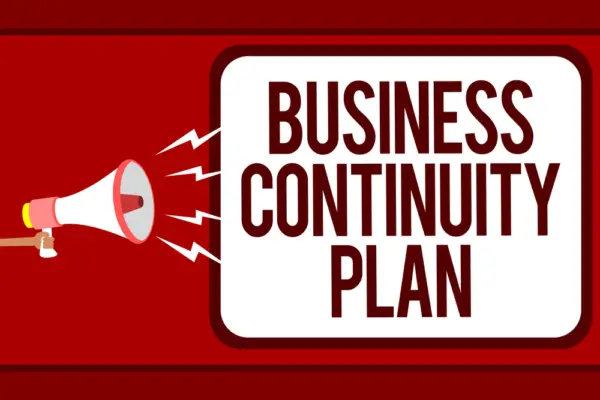Creating an effective business continuity plan is crucial for any organization, regardless of its size or industry.
A business continuity plan is a set of procedures and policies that outline how a company will respond to a crisis or disaster, ensuring that it can continue to operate and deliver products or services to its customers.
The plan should include strategies for dealing with various scenarios, such as natural disasters, cyber-attacks, power outages, or pandemics, among others.
A well-designed business continuity plan can help companies minimize the impact of a crisis, reduce downtime, and avoid financial losses.
It can also help them maintain their reputation and credibility, as customers and stakeholders expect businesses to be prepared for unexpected events.

However, creating a business continuity plan can be a complex and time-consuming process, requiring input from various departments and stakeholders.
Therefore, it’s essential to follow a structured and comprehensive approach that covers all the critical aspects of the plan, from risk assessment to testing and maintenance.
Understanding Business Continuity Planning
Defining Business Continuity Plan (BCP)
A Business Continuity Plan (BCP) is a documented process that outlines how an organization will continue to operate during and after a disruption.
It is a comprehensive plan that covers all aspects of an organization’s operations, from IT infrastructure to human resources.
The BCP ensures that the organization can continue to function during and after a disruption, minimizing the impact on the business, employees, and customers.
Importance of BCP in Organizational Resilience
The importance of a BCP cannot be overstated. Disruptions can occur at any time and can be caused by a variety of factors, including natural disasters, cyber-attacks, and human error.
Without a BCP, an organization may struggle to recover from a disruption, leading to financial losses, reputational damage, and even business failure.
A BCP helps an organization identify potential risks and disruptions, and develop strategies to mitigate them.
It outlines the steps that need to be taken to ensure that critical operations can continue during and after a disruption.
This includes identifying key personnel and resources, establishing communication protocols, and developing recovery plans.
BCP is an essential tool for any organization that wants to ensure its resilience in the face of disruptions.
By identifying potential risks and disruptions, and developing strategies to mitigate them, an organization can minimize the impact of a disruption and ensure that critical operations can continue.
Elements of a Business Continuity Plan
A Business Continuity Plan (BCP) is a comprehensive document that outlines an organization’s strategy for responding to potential disasters or disruptions.
It is essential to have a well-defined BCP in place to minimize the impact of any crisis on the organization’s operations, reputation, and financial stability.
Here are the key elements of a BCP that every organization should include:
Key Components of a BCP
A BCP should include a detailed analysis of potential risks and threats that the organization may face.
It should identify critical business functions and processes and prioritize them based on their importance and potential impact on the organization.
The plan should also define the resources required to maintain essential functions during a crisis, including personnel, technology, and facilities.
Roles and Responsibilities
A BCP should define the roles and responsibilities of the team members responsible for implementing the plan.
It should also identify the key stakeholders who will be involved in the recovery process, including customers, suppliers, and employees.
The plan should clearly define the chain of command and communication protocols to ensure that all team members are aware of their roles and responsibilities.
Scope and Objectives
The BCP should define the scope and objectives of the plan, including the level of disruption that the organization can tolerate and the recovery time objectives for critical business functions.
It should also include a plan B in case the initial strategy fails to achieve the desired results. The plan should be regularly reviewed and updated to ensure that it remains relevant and effective.
An effective BCP is essential for any organization to minimize the impact of potential disasters or disruptions on its operations and reputation.
By including the key components of a BCP, defining roles and responsibilities, and setting clear objectives, organizations can ensure that they are prepared to respond to any crisis confidently and efficiently.
Risk Assessment and Business Impact Analysis
Creating an effective business continuity plan requires a thorough understanding of the potential risks and impacts on critical business functions.
This is achieved through conducting a risk assessment and performing a business impact analysis (BIA).
Conducting a Risk Assessment
A risk assessment is the process of identifying potential threats to an organization and assessing the likelihood and impact of those threats.
The goal is to create a risk profile that identifies the most significant risks to the organization.
The risk profile should include a description of each risk, the likelihood of occurrence, the potential impact on critical business functions, and the level of risk tolerance.
To conduct a risk assessment, the organization should identify its assets, including physical assets, information assets, and personnel.
They should then identify potential threats to those assets, such as natural disasters, cyber-attacks, or supply chain disruptions.
Once the threats have been identified, the organization should assess the likelihood of occurrence and the potential impact on critical business functions.

Performing Business Impact Analysis (BIA)
A business impact analysis (BIA) is the process of identifying critical business functions and assessing the potential impact of disruptions to those functions.
The goal is to identify the resources needed to recover critical business functions and prioritize recovery efforts.
To perform a BIA, the organization should identify its critical business functions, including the processes, systems, and personnel needed to perform those functions.
They should then assess the potential impact of disruptions to those functions, including the financial impact, operational impact, and reputational impact.
The results of the risk assessment and BIA should be used to inform the development of the business continuity plan.
The plan should include strategies for mitigating risks, recovering critical business functions, and communicating with stakeholders.
The plan should also be tested and updated regularly to ensure its effectiveness in the event of a disruption.
Business Continuity Strategies and Solutions
Developing a business continuity plan is critical to minimize the impact of business disruption caused by unforeseen events such as cyberattacks, natural disasters, or data breaches.
The plan should provide a framework for how the organization will continue to operate during and after the disruption.
Developing Recovery Strategies
One of the key components of a business continuity plan is developing recovery strategies.
Recovery strategies should identify the critical business processes and systems that need to be restored first during a disruption.
The recovery strategies should also include a plan for how to recover the IT infrastructure and data to minimize the impact on the organization.
To develop effective recovery strategies, the organization should conduct a business impact analysis to identify critical business processes and systems.
The business impact analysis should also identify the recovery time objective (RTO) and recovery point objective (RPO) for each critical process and system.
The RTO is the maximum amount of time a process or system can be down before it affects the organization’s operations, while the RPO is the maximum amount of data loss that the organization can tolerate.
Planning for IT Infrastructure and Data
Planning for IT infrastructure and data is another critical component of a business continuity plan.
The plan should include a strategy for how to recover the IT infrastructure and data in the event of a disruption.
To develop an effective IT infrastructure and data recovery plan, the organization should identify the critical IT systems and data that need to be backed up regularly.
The organization should also consider using a cloud-based backup solution to ensure that the data is protected and can be easily restored in the event of a disruption.
In conclusion, developing effective recovery strategies and planning for IT infrastructure and data are critical components of a business continuity plan.
The plan should provide a framework for how the organization will continue to operate during and after a disruption.
The plan should also be regularly reviewed and updated to ensure that it remains relevant and effective.
Emergency Response and Operations
When a crisis or emergency occurs, it is essential to have a plan in place to ensure the safety of employees, customers, and critical processes.
This plan should include emergency management and response procedures, as well as strategies for maintaining critical operations during and after the crisis.
Emergency Management and Response
Emergency management and response procedures should be developed and implemented to ensure that the organization can quickly and effectively respond to any crisis.
This includes identifying potential threats, developing response plans, and training employees on how to respond to emergencies.
One effective way to manage emergencies is to establish an incident command system (ICS). An ICS is a standardized approach to emergency management that provides a clear chain of command and communication during an emergency.
This system ensures that everyone involved in the response effort understands their roles and responsibilities, and that communication is clear and concise.
Maintaining Critical Operations
During a crisis, it is important to maintain critical operations to ensure that the organization can continue to function and provide essential services to customers.
This may include identifying critical processes and developing contingency plans to ensure that they can continue to operate during and after the crisis.
One way to maintain critical operations is to establish a business continuity plan (BCP). A BCP is a comprehensive plan that outlines how the organization will continue to operate during and after a crisis.
This plan should include strategies for maintaining critical processes, identifying alternative resources and suppliers, and ensuring that employees have the tools and resources they need to continue working.
In addition to developing a BCP, it is important to work closely with emergency responders to ensure a coordinated response effort.
This may include identifying key contacts within local emergency services and establishing communication protocols to ensure that everyone is on the same page during an emergency.
Overall, effective emergency response and operations require careful planning, clear communication, and a coordinated effort between all stakeholders.
By developing comprehensive emergency management and response procedures, maintaining critical operations, and working closely with emergency responders, organizations can minimize the impact of a crisis and ensure a quick and effective recovery.

Communication and Information Sharing
Effective communication is key to the success of any business continuity plan. It is important to establish clear communication channels and ensure that all stakeholders are aware of the plan and their roles in it.
This section will discuss the internal and external communication strategies that should be included in a business continuity plan.
Internal Communication Plan
The internal communication plan outlines how information will be shared within the organization during a disruption.
This plan should include contact information for key personnel, such as the business continuity team, IT staff, and department heads.
It should also outline the communication channels that will be used, such as email, phone, or instant messaging.
To ensure that all employees are aware of the plan, it is important to provide regular training and awareness sessions.
This will help to ensure that everyone understands their role in the plan and knows what to do in the event of a disruption.
Regular testing of the plan will also help to identify any communication gaps and ensure that the plan is effective.
External Communication with Stakeholders
In addition to internal communication, it is important to have a plan for communicating with external stakeholders, such as customers, suppliers, and partners.
This plan should include contact information for key stakeholders and outline the communication channels that will be used.
During a disruption, it is important to keep stakeholders informed of the situation and provide regular updates on the status of the recovery efforts.
This will help to maintain trust and confidence in the organization and minimize any negative impact on the business.
To ensure that the external communication plan is effective, it is important to test it regularly and make any necessary updates.
This will help to ensure that the plan is up-to-date and that all stakeholders can be reached quickly and efficiently.
Effective communication and information sharing is critical to the success of any business continuity plan.
By establishing clear communication channels and regularly testing the plan, organizations can ensure that all stakeholders are aware of the plan and their roles in it.
This will help to minimize the impact of any disruptions and ensure that the organization can recover quickly and efficiently.
Training, Testing, and Exercises
A business continuity plan is only effective if everyone in the organization is aware of it and knows what to do in case of a disaster.
This is where training, testing, and exercises come into play.
Employee Training and Awareness
It is essential to provide regular training to all employees to ensure they understand the business continuity plan and their role in it.
This training should include information on the plan’s purpose, scope, and the actions employees should take in case of an emergency.
Moreover, employees should be trained on how to use the communication channels and technology required to implement the plan.
By providing regular training, employees will be more confident and prepared to respond to a disaster, reducing the risk of confusion or mistakes.
Regular Testing and Drills
Testing and drills are crucial for identifying gaps or weaknesses in the business continuity plan.
Regular testing and drills should be conducted to ensure that the plan is effective and up-to-date.
A test should be performed to assess the plan’s effectiveness, identify areas for improvement, and ensure that all personnel are familiar with the plan’s procedures.
Regular testing also ensures that the plan remains relevant and effective as the organization evolves.
By conducting regular testing and drills, the organization can identify areas where the plan needs improvement and take corrective action.
Testing and drills should be conducted at least annually and after any significant changes to the plan or the organization.
Training, testing, and exercises are essential components of an effective business continuity plan.
By providing regular training to all employees and conducting regular testing and drills, the organization can ensure that the plan is effective, up-to-date, and relevant.
Plan Maintenance and Continuous Improvement
Creating a business continuity plan (BCP) is just the first step. To ensure its effectiveness, it is essential to maintain and continuously improve the plan.
This section will discuss two critical aspects of plan maintenance and continuous improvement: updating and reviewing the BCP and incorporating lessons learned.
Updating and Reviewing the BCP
A BCP is not a one-time project but an ongoing process that requires regular maintenance and updates. As the business landscape evolves, the plan must be updated to reflect changes in the organization’s structure, processes, and technologies.
It is recommended to review and update the BCP at least once a year or whenever there is a significant change in the organization.
This includes updating contact information, roles and responsibilities, and recovery procedures.
Organizations should also conduct regular tests and drills to identify weaknesses and areas for improvement.
Testing helps to ensure that the plan is still effective and that employees are aware of their roles and responsibilities.
Incorporating Lessons Learned
Lessons learned are an essential part of continuous improvement. After a disruption, it is crucial to conduct a post-incident review to identify what worked well and what didn’t.
Organizations should document the lessons learned and incorporate them into the BCP. This includes updating procedures, revising recovery objectives, and identifying new risks.
It is also essential to communicate the lessons learned to all employees and stakeholders to ensure that they are aware of the changes and can provide feedback.
Maintaining and continuously improving the BCP is critical to ensure its effectiveness. Regular updates, testing, and incorporating lessons learned help to ensure that the plan is up-to-date, relevant, and effective.
Legal and Compliance Considerations
When creating a business continuity plan, it is crucial to consider legal and compliance requirements.
Failure to comply with regulations can lead to legal issues, financial penalties, and damage to the organization’s reputation.
This section outlines the key legal and compliance considerations to keep in mind when creating a business continuity plan.
Understanding Legal Requirements
The legal requirements for business continuity planning vary depending on the industry and jurisdiction.
Organizations must be aware of the relevant laws and regulations that apply to their operations and ensure that their business continuity plan is compliant with them.
This may include laws related to data protection, privacy, and security, as well as industry-specific regulations.
Organizations should also consider the potential legal implications of their business continuity plan.
For example, if a disaster occurs, and the organization fails to meet its obligations under the plan, it could face legal action from stakeholders, including customers, employees, and shareholders.
Therefore, it is essential to ensure that the plan is legally sound and that all stakeholders are aware of their roles and responsibilities.
Ensuring Compliance with Regulations
In addition to legal requirements, organizations must also comply with various regulations when creating a business continuity plan.
Compliance ensures that the organization’s operations are in line with industry standards and best practices, reducing the risk of disruptions and financial losses.
Organizations should consider the following when ensuring compliance with regulations:
- Identify the regulations that apply to their operations and ensure that the business continuity plan is compliant with them.
- Ensure that the plan is regularly reviewed and updated to reflect changes in regulations and industry standards.
- Train employees on compliance requirements and ensure that they understand their roles and responsibilities.
- Monitor compliance with the plan and take corrective action if necessary.
Legal and compliance considerations are essential when creating a business continuity plan. Organizations must be aware of the relevant laws and regulations, ensure that their plan is compliant, and monitor compliance regularly.
Failure to comply with legal and regulatory requirements can lead to legal issues, financial penalties, and damage to the organization’s reputation.

Frequently Asked Questions
What are the key roles and responsibilities in a business continuity plan?
A business continuity plan (BCP) involves a team of individuals with specific roles and responsibilities.
The team should include a business continuity manager, who is responsible for overseeing the plan’s development and implementation.
Other key roles may include a crisis management team, IT recovery team, and a communications team.
Each team member must understand their role and responsibilities and be prepared to act quickly and efficiently in the event of a disruption.
How can a business continuity and disaster recovery plan be integrated?
A business continuity plan (BCP) and disaster recovery plan (DRP) are complementary but distinct plans.
The DRP focuses on the technical recovery of IT systems and infrastructure, while the BCP focuses on the overall business operations.
To integrate the two plans, it is essential to identify the critical business functions and the IT systems that support them.
The BCP and DRP should be tested together to ensure they work seamlessly in the event of a disaster.
What are the essential elements to include in a business continuity plan checklist?
A business continuity plan (BCP) checklist should include essential elements such as identifying critical business functions and processes, conducting a risk assessment, developing a communication plan, creating a crisis management plan, and testing the plan regularly.
The checklist should also include a plan for data backup and recovery, identifying alternate work locations, and ensuring employee safety and well-being.
Where can one find a reliable business continuity plan template?
Business continuity plan (BCP) templates can be found online, but it is essential to ensure that the template is reliable and fits the organization’s needs.
A reliable template should include essential elements such as identifying critical business functions, conducting a risk assessment, developing a communication plan, creating a crisis management plan, and testing the plan regularly.
The template should be customizable to fit the organization’s specific needs.
What are the main components of a comprehensive business continuity framework?
A comprehensive business continuity framework should include the following components: governance and leadership, risk management, business impact analysis, strategy development, plan development, testing and exercising, and program management.
Each component is essential to developing and implementing an effective business continuity plan.
How should a business continuity policy be structured to ensure effectiveness?
A business continuity policy should be structured to ensure effectiveness by including clear objectives, roles, and responsibilities, defining critical business functions and processes, identifying potential risks, developing a communication plan, and testing the plan regularly.
The policy should also be reviewed and updated regularly to ensure it remains relevant and effective.

Chris Ekai is a Risk Management expert with over 10 years of experience in the field. He has a Master’s(MSc) degree in Risk Management from University of Portsmouth and is a CPA and Finance professional. He currently works as a Content Manager at Risk Publishing, writing about Enterprise Risk Management, Business Continuity Management and Project Management.

